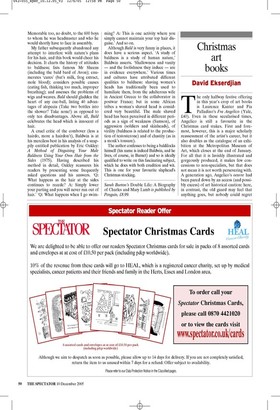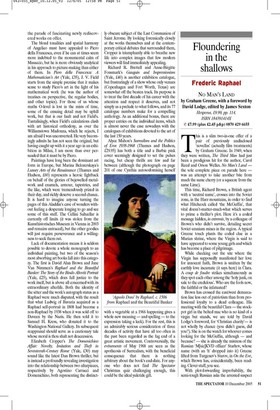Christmas art books
David Ekserdjian
The only halfway festive offering in this year’s crop of art books is Laurence Kanter and Pia Palladino’s Fra Angelico (Yale, £40). Even in these secularised times, Angelico is still a favourite in the Christmas card stakes. First and foremost, however, this is a major scholarly reassessment of the artist’s career, but it also doubles as the catalogue of an exhibition at the Metropolitan Museum of Art, which closes at the end of January. For all that it is lavishly illustrated and gorgeously produced, it makes few concessions to non-specialists, but that does not mean it is not worth persevering with. A generation ago, Angelico’s oeuvre had been pared down by an access (and possibly excess) of art historical caution: here, in contrast, the old guard may feel that anything goes, but nobody could regret the parade of fascinating newly rediscovered works on offer.
The blond tonalities and spatial harmony of Angelico must have appealed to Piero della Francesca, even if he can at times seem more indebted to the monumental calm of Masaccio, but he is more obviously analytical in his approach to picture-making than either of them. In Piero della Francesca: A Mathematician’s Art (Yale, £35), J. V. Field starts from the simple premise that it makes sense to study Piero’s art in the light of his mathematical work (he was the author of treatises on perspective, the regular bodies, and other topics). For those of us whose maths O-level is lost in the mists of time, some of the ensuing detail may be uphill work, but that is our fault and not Field’s. Tantalisingly, when Field’s calculations clash with art historical orthodoxy, as over the Williamstown Madonna, which he rejects, I am afraid I was unconverted. He very becomingly admits he has not seen the original, but having caught up with it a year ago in an exhibition in Milan, I am more than ever persuaded that it must be by Piero.
Paintings have long been the dominant art form in Europe, but Marina Belozerskaya’s Luxury Arts of the Renaissance (Thames and Hudson, £60) represents a heroic fightback on behalf of the glories of bejewelled metalwork and enamels, armour, tapestries, and the like, which were tremendously prized in their day, and richly deserve a second chance. It is hard to imagine anyone turning the pages of this Aladdin’s cave of wonders without feeling a desperate longing to go and see some of this stuff. The Cellini Saltcellar is currently off limits (it was stolen from the Kunsthistorisches Museum in Vienna in 2003 and remains untraced), but the other goodies will just require perseverance and a willingness to seek them out.
Lack of documentation means it is seldom possible to devote a whole monograph to an individual painting, but two of the season’s most absorbing art books fall into this category. The first is David Alan Brown and Jane Van Nimmen’s Raphael and the Beautiful Banker: The Story of the Bindo Altoviti Portrait (Yale, £25), which does full justice to the work itself, but is above all concerned with its extraordinary afterlife. Both the identity of the sitter and the work’s autograph status as a Raphael were much disputed, with the result that what Ludwig of Bavaria acquired as a Raphael self-portrait in 1808 had become a non-Raphael by 1938 when it was sold off to Duveen by the Nazis. He then sold it to Samuel H. Kress, who donated it to the Washington National Gallery. Its subsequent reappraisal should serve as a cautionary tale whose moral is thou shalt not deaccession.
Elizabeth Cropper’s The Domenichino Affair: Novelty, Imitation and Theft in Seventeenth-Century Rome (Yale, £30) may sound like the latest Dan Brown thriller, but is instead a profoundly revealing investigation into the relationship between two altarpieces, respectively by Agostino Carracci and Domenichino, both representing the distinct ly obscure subject of the Last Communion of Saint Jerome. By looking forensically closely at the works themselves and at the contemporary critical debates that surrounded them, Cropper is triumphantly able to breathe new life into complex images that few modern viewers will find immediately appealing.
Richard R. Brettell and Anne-Birgitte Fonsmark’s Gauguin and Impressionism (Yale, £40) is another exhibition catalogue, but frustratingly of a show whose only venues (Copenhagen and Fort Worth, Texas) are somewhat off the beaten track. Its purpose is to treat the first decade of his career with the attention and respect it deserves, and not simply as a prelude to what follows, and its 77 catalogue numbers make for a compelling anthology. As an additional bonus, there are proper entries on the individual items, which is almost never the case nowadays with the catalogues of exhibitions devoted to the art of the last 150 years.
Alyce Mahon’s Surrealism and the Politics of Eros 1938-1968 (Thames and Hudson, £29.95) has both a title and a Barbie pink cover seemingly designed to set the pulses racing, but cheap thrills are few and far between (although the photograph on page 201 of one Cynthia autosodomising herself with a vegetable at a 1966 happening gives a whole new meaning — and spelling — to the expression taking a leek). For the rest, this is an admirably serious consideration of three decades of activity that have all too often in the past been regarded as the fag end of a great artistic movement. Controversially, the evénements of May 1968 are seen as the apotheosis of Surrealism, with the beneficial consequence that there is nothing arbitrary about the book’s end-date. For anyone who does not find The Spectator Christmas quiz challenging enough, this could be the ideal yuletide gift.


























































 Previous page
Previous page